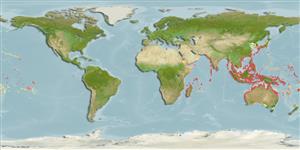Common names from other countries
Environment: milieu / climate zone / depth range / distribution range
Écologie
; saumâtre; profondeur 0 - 20 m (Ref. 101198). Tropical, preferred 27°C (Ref. 107945); 46°N - 39°S, 26°E - 134°W (Ref. 106948)
Indo-Pacific.
Length at first maturity / Taille / Poids / Âge
Maturity: Lm ?, range 2 - 2.1 cm Max length : 9.0 cm SHL mâle / non sexé; (Ref. 348); common length : 6.0 cm SHL mâle / non sexé; (Ref. 348); âge max. reporté: 12 années (Ref. 126573)
Description synthétique
Morphologie
Shell equivalve, thick and solid, ovate, strongly inflated, slightly longer than high and feebly inequilateral. Umbones strongly protruding, cardinal area rather large. About 18 radial ribs (15 to 20) with wide interstices at each valve; ribs stout and distinctly rugose, bearing regular, often rectangular nodules. Periostracum rather thin and smooth. Internal margins with strong crenulations corresponding with the external radial ribs. No byssal gape. Colour: outside of shell white under the yellowish brown periostracum. Inner side white, often tinged yellow towards the umbonal cavity.
This represents the most important commercial ark (Ref. 348).
Life cycle and mating behavior
Maturité | Reproduction | Frai | Œufs | Fécondité | Larves
Members of the class Bivalvia are mostly gonochoric, some are protandric hermaphrodites. Life cycle: Embryos develop into free-swimming trocophore larvae, succeeded by the bivalve veliger, resembling a miniature clam.
Poutiers, J.M. 1998. (Ref. 348)
Statut dans la liste rouge de l'IUCN (Ref. 130435: Version 2024-1)
statut CITES (Ref. 108899)
Not Evaluated
Not Evaluated
Menace pour l'homme
Harmless
Utilisations par l'homme
Pêcheries: commercial
FAO - Aquaculture: production; pêcheries: landings, species profile | FishSource | Sea Around Us
Outils
Sources Internet
Estimates based on models
Preferred temperature
(Ref.
115969): 21.8 - 29.3, mean 28.4 (based on 3701 cells).
Résilience
Haut, temps minimum de doublement de population inférieur à 15 mois (K=0.54-4.34; tm=0.6; tmax=12).
Prior r = 0.85, 95% CL = 0.56 - 1.28, Based on 2 data-limited stock assessments.
Vulnérabilité
Low to moderate vulnerability (28 of 100).
